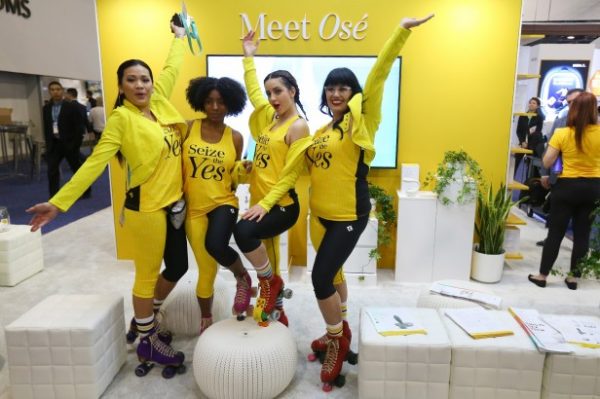Sex tech is slowly making a comeback at CES. About time. – MIT Technology Review
In 2019, Lora DiCarlo created a product so innovative that it won a major award at CES, the world’s biggest tech conference. Osé—a $290 device designed to stimulate both a woman’s clitoris and her G-spot to achieve a “blended orgasm”—then promptly got its award revoked by CES’s parent company, the Consumer Technology Association (CTA), which called Osé “obscene.”
“I was appalled, because we don’t think sexual health is obscene—it’s sacred,” DiCarlo says. “Sexual health is human health.”
After a public outcry, CES decided to return the award. Awkward.
The show appears to have learned from the whole embarrassing debacle. One year on, CES is allowing sex tech companies, many of which are run by women, to showcase their products on a trial basis in one of the less prestigious sections of this week’s conference.
“After CES 2019, CTA started some important conversations internally and with external advisors,” CTA said in an official comment. “We decided to permit the inclusion of tech based sexual technology products at CES 2020 on a trial basis. As we do every year, we will follow our standard policies and procedures following this year’s show to determine next steps.”
This tacit acknowledgement that sex tech can no longer be ignored is all part of a recalibration at CES toward greater inclusivity for female entrepreneurs and attendees. But it is also a savvy business move. Andrea Barrica, a former venture capitalist and author of Sex(Tech) Revolution: The Future of Sexual Wellness, has estimated that Amazon now sells 60,000 sexual wellness products that brought in around $800 million in sales in 2018. But the typical ad structure of the internet today—click on a product, thereby acknowledging an interest in it, and then have listings for that product appear on pages you subsequently browse—aren’t used with sex tech the company sells. That’s primarily because most people would be embarrassed to have a vibrator ad, for example, pop up at work. Google and Facebook severely restrict advertising on this front as well.
One prominent sex tech company at CES this year is Dame, cofounded by a sexologist and an engineer. Its sex toy Fin was the first to be allowed on Kickstarter, but it has also suffered from the industry’s image problem. In 2019 the company sued New York City’s MTA for rejecting its advertising campaign, alleging sexism.
“The lack of visibility means consumers don’t know that other people use these products, and they don’t know how widespread sex toy use is,” says Janet Lieberman-Lu, cofounder of Dame. “Therefore, they feel isolated in using them. It really amplifies the shame and isolation that people feel, especially women.”
AP
There’s evidence that sex tech is becoming increasingly legitimized and accepted, however. Venture capitalists are taking note: DiCarlo secured $2 million in the aftermath of the CES scandal, and Stratistics, a market research firm, estimates the industry could be worth $123 billion by 2026. The industry group Women in Sex and Tech now has more than 120 members.
DiCarlo says she has noticed a recent shift in attitude. “The reactions have been positive and encouraging,” she says. “Based on our reception this year, I do believe we’re gaining acceptance.”
Lieberman-Lu agrees. “I notice a lot more intention for inclusivity than I did even five years ago, and there’s a vocabulary we’ve all been armed with post-#MeToo that makes it easier to put what bothers us into words,” she says. “I think that also makes it easier to be an ally—I’ve had a lot more men stick up for me in conversation than I used to, or check in with me afterwards to see how a marginalizing comment made me feel.”
Cindy Gallop, the founder and CEO of Make Love Not Porn, a video-sharing platform, says that with sex tech, women are solving problems that have long been ignored or overlooked by men. But she argues that the CTA’s change of heart is too little, too late.
CES has been forced “kicking and screaming” to take women in sex tech seriously, she says.
Gallop says that she’s applied twice as a keynote speaker on sex tech. Instead, she received emails back saying “something along the lines of ‘I’m afraid this is not a topic that we want to see at CES.’”
Her experience speaks to a larger issue around women in tech that goes beyond the industry’s blind spot about sex products. In 2017 and 2018, CES came under fire for not having a single female keynote speaker; the organizers went on to publish a blog post blaming this on the lack of women in leadership positions.
This year, CES has attempted to counter its reputation for sexism and misogyny with new dress codes designed to effectively eliminate the show’s “booth babes.” It has also partnered with Female Quotient, an “equality partner” that advocates for gender diversity in the workplace. And on Tuesday night, the CTA touted its female keynote speaker: Ivanka Trump, a senior advisor to the president.
Trump’s choice was supposed to assuage this problematic boys’ club image, but instead, it elicited fierce protest. On Tuesday night, DiCarlo published an open letter asking the CTA why Trump had been deemed an appropriate voice for women at tech’s biggest conference, simultaneously calling for more female speakers.
“Why book someone to keynote at CES, a hugely anticipated and exciting event for innovators and change makers, who has so little tech experience?” wrote DiCarlo, who also announced that her brand had won two more awards from the show this year. “The simple question keeps spinning around in my head, coupled with ‘What does the tech community actually want instead?’”
Editors note: We updated this story to include a comment from CTA.






